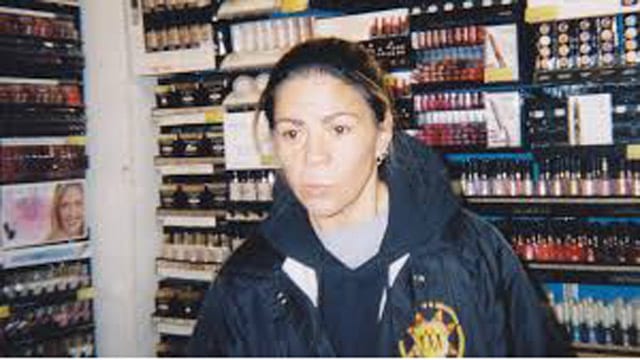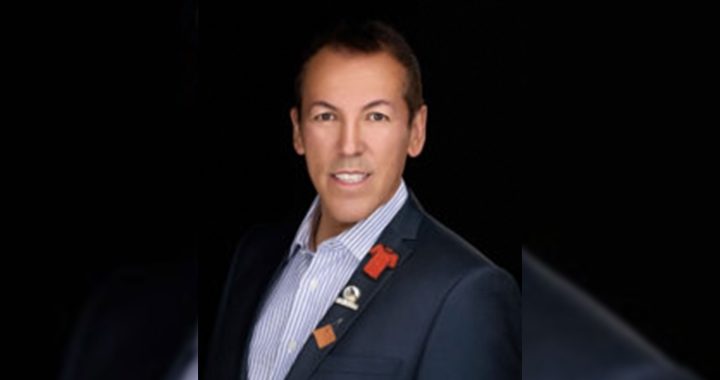Three days after she was sentenced to life in prison for murdering a man with a knife through the neck, Connie Oakes, wearing a grey T-shirt and grey sweatpants, picked up the telephone receiver on the other side of the plexiglass in the visiting area of the Medicine Hat, Alta., remand centre and said she didn’t do it.
Oakes, who was waiting for a federal prison transfer to Edmonton to serve a sentence with no chance of parole for 14 years, said in the jailhouse interview with APTN National News she wrote a message to the family of Casey Armstrong, the man a jury said she murdered.
Armstrong was found with his neck nearly severed in the bathtub of his trailer on May 22, 2011. The bathroom was a mess of blood, dried pools on the washing machine, splash patterns on the walls, the bloody print of a man’s work boot on the floor.
“To the Armstrong family, I empathize with your loss of a loved one. I sincerely hope they find the right person or persons responsible for this horrific crime, however, I feel you need to hear this from me personally,” said Oakes, a Cree woman from the Nekaneet First Nation in southern Saskatchewan. “I am innocent.”
Oakes, 49, said she wanted to read the note to the family during her June 5 sentencing hearing, but was advised against it by her lawyer.
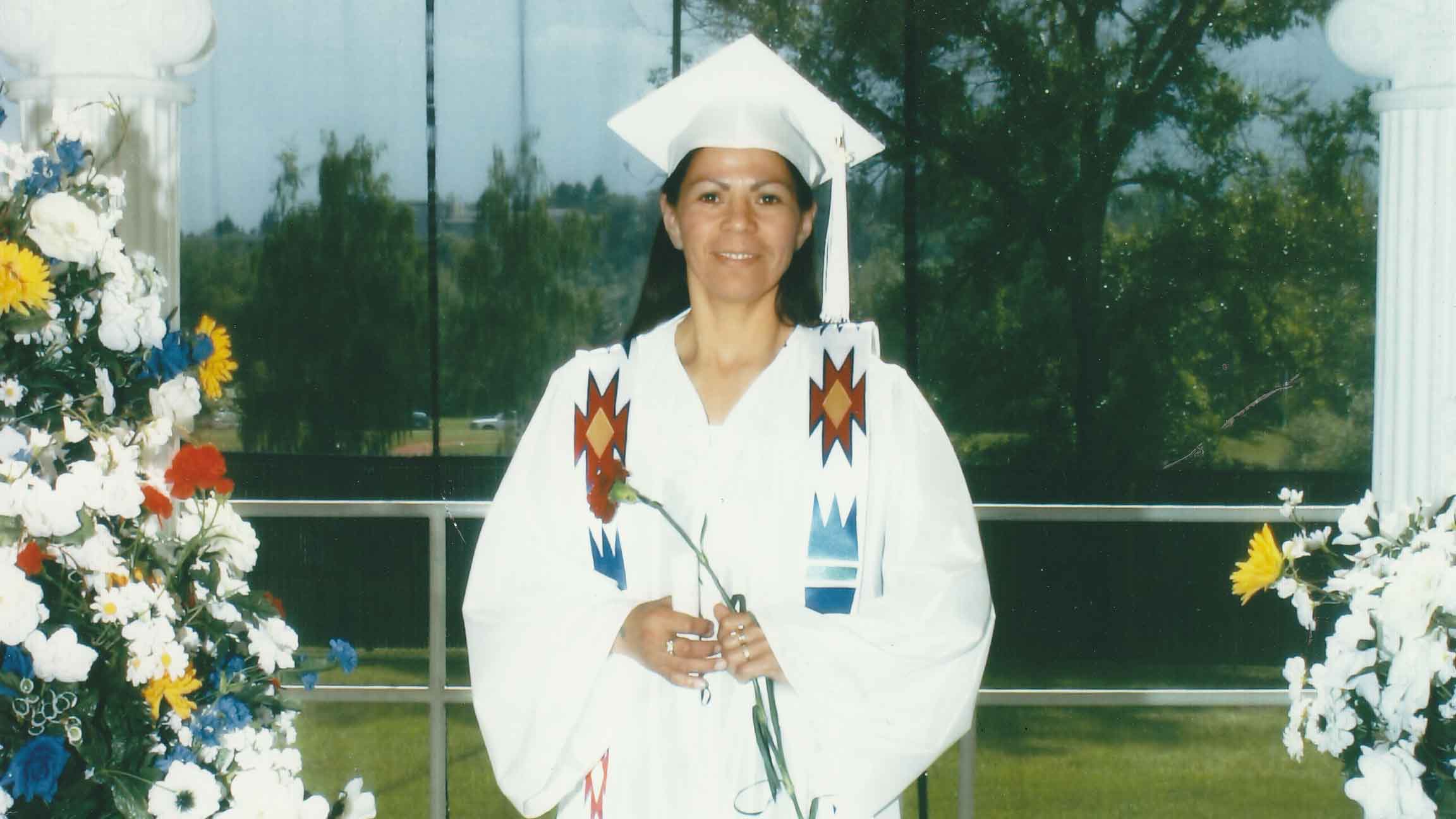
The Medicine Hat News reported a cheer erupted in the courtroom after the jury of five men and seven women, all Medicine Hat residents, none First Nation, came back after one day of deliberations to deliver a guilty verdict on November 15, 2013.
The whole of the Crown’s case rested on the shoulders of Wendy Scott, also known as Wendy Herman, a 29-year-old small-time crack dealer described by police and the Crown as having the mind of a child.
Before she pointed an accusatory finger at Oakes for the murder, Scott named three different people to police as the possible killers.
Major crime investigators with the Medicine Hat police failed to find any fingerprints or DNA from Oakes or Scott at the scene and never recovered the murder weapon.
A knife submitted as an exhibit during the trial returned from the forensic lab with no trace of blood or any DNA. Investigators were also never able to explain the origin of the bloody boot print.
“I don’t have it in me to do something like that,” said Oakes, in a telephone interview Saturday with APTN from the Edmonton Institution for Women, where she is serving her sentence. “The Creator is the only one who can make the call to take someone.”
The Crown prosecutor who handled the case said there is no doubt the jury convicted the right woman.
“I think the community is safer,” said Andrea Dolan, the Crown prosecutor. “I have no concerns with respect to the process and how it worked. I think the process worked in this situation.”
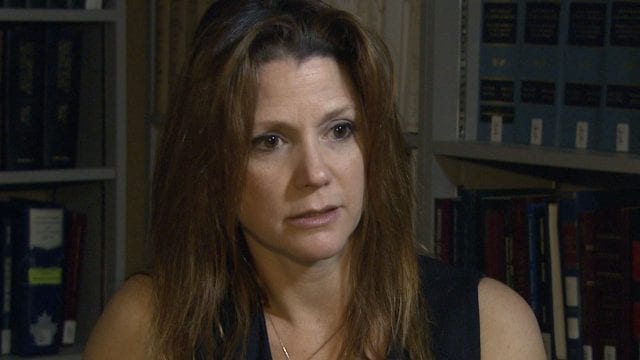
For the Medicine Hat police officer who oversaw the final phase of the murder investigation, there is no question Oakes plunged the knife through Armstrong’s neck.
“Connie killed Casey Armstrong,” said Sgt. Brent Secondiak.
Oakes’ guilty verdict, however, weighs heavily on her Edmonton-based defence lawyer, Daryl Royer.
He still questions his handling of the case and his decision not to allow Oakes to testify in her defence.
Royer believed the Crown’s case was so weak there was no need for the defence to call any evidence given the main witness, Scott, had at least 55 inconsistencies or contradictions in her testimony during the trial.
“I have spoken to lawyers that ran murder trials 25, 30 years ago where they believed their clients were wrongfully convicted and they never forgot and they live with it the rest of their lives,” said Royer. “I don’t know how I am ever going to come to grasp with it.”
Oakes’ new lawyer, Edmonton-based Alex Simic, filed a notice of appeal on the murder conviction this past Friday.
Last Night on Earth
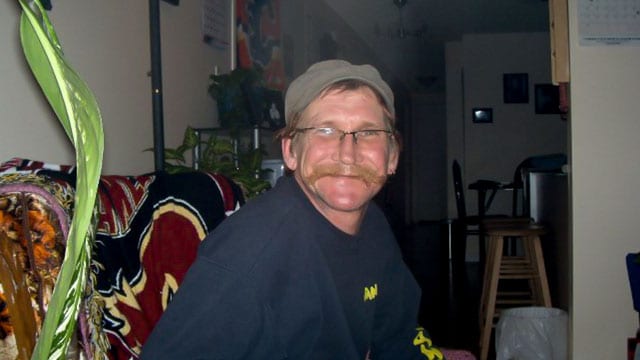
Curtis Harvey, a local school bus driver, was the man who found Armstrong dead in the bathtub.
Bound by a decades-long friendship, the two often hung out together, playing cribbage, drinking beers and sharing the occasional marijuana joint. Armstrong was growing a couple of plants. On Friday morning, May 20, 2011, Harvey went to Armstrong’s trailer.
After playing a few games of crib he drove Armstrong, who didn’t have a driver’s license, to the drug store to pick up a prescription of Percocet pills. The Percocet was for Armstrong’s nagging knee problem and he sometimes shared the pills with friends, Harvey testified.
After they picked up the pills, Harvey and Armstrong went to the Royal Hotel bar for a couple of beers and then back to the trailer where they hung out until about 6 p.m.
At about 8:30 p.m. that evening, wearing his ragged Calgary Flames slippers held together by duct tape, Armstrong went to Peanuts pub, which is just a few steps away from his trailer.
Armstrong was a regular at the pub, which is now called Rider’s Roost, and he had a lucky night winning some cash at the VLT machine, the former pub manager Terry Lynn Russell testified. He left at about 11 p.m. to watch a hockey game.
It was his last night on earth.
The next morning, Saturday, Russell testified she saw two women outside the trailer with an “old red car”. One woman, wearing a baseball cap over her “reddish hair,” was putting “a garbage bag or a black duffle bag” into the trunk, Russell testified.
Russell described both women as being thin, the one with reddish hair thinner than the second woman with long dark hair. Both wore “ill-fitting clothes” including “T-shirts that were way too big for them and baggy pants. Sloppy,” testified Russell, according to the trial transcript.
Russell initially said in a statement to police she thought the women were in their mid-20s. She described the woman with long dark hair as tall. She also initially stated they put a black duffle bag in the trunk of the red “beater” car.
During cross-examination, Russell said she believed the two women were Caucasian.
Russell assumed it was one of Armstrong’s kids getting ready to go camping that long weekend. Armstrong has a son and a daughter who are both in their early 20s. The son was living with Armstrong at the time of the murder but was gone for the weekend.
Harvey called Armstrong several times that Saturday. No answer on the home phone or the cell phone.
The next day, on Sunday morning, May 22, 2011, Harvey put six beers into a cooler and went to Armstrong’s trailer.
It was 10 a.m. and the door was locked. Armstrong, who sometimes locked his door while home, previously told Harvey there was a key underneath a pillow on the porch. Harvey found the key, opened the door, and saw shoes scattered at the entrance. The television was on.
The Elusive Alibi
May 19 is a painful day for Oakes. It’s the birthday of her first son Jameson John who was killed on Halloween in 2002, two weeks after Oakes stepped out of federal prison in Edmonton after serving a sentence for drug possession and trafficking.
She was convicted in 1999 after selling a 60-milligram morphine tablet to an undercover Medicine Hat police officer. Oakes was also found with marijuana, morphine, and hydromorphone during a separate traffic stop.
J.J., as she calls him, was walking on a country road near Maple Creek, Sask., when he was hit by a young woman who was visiting the area from another reserve. She was driving drunk, chasing her mother. J.J. was walking with several other young men.
The mother swerved to avoid the young men, but the daughter hit two of them, killing J.J.
Oakes said she always mourned her son’s death on that date and spent the weekend in May 2011 crying with a friend and spending time alone in her trailer.
“It was a long weekend and I do remember taking a bus to a friend’s place. That date triggers me, it was my son’s birthday. I went over to a friend’s place and shed a few tears in front of him,” said Oakes, during the telephone interview with APTN. “I was nowhere near Casey’s place.”
Oakes knew Armstrong. He used to be good friends with her ex-husband and visited often. Once she asked him to look after her middle son Joe, who was an infant at the time, while she ran to the store to buy cigarettes.
When she came home, Armstrong was cradling her son.
“After Wayne (her ex-husband) and I separated, I kind of lost track of Casey. I would see him now and then at the Royal and say hi,” said Oakes.
She said she heard about Armstrong’s killing on the radio and went to his memorial.
“He was a good guy,” she said. “He had a big heart. His heart was an open door. He’d help out anybody. He was a real good guy.”
In an alibi letter to the Crown, Royer named two men who possibly knew Oakes’ whereabouts on that May long weekend. During Oakes’ bail hearing, Royer also mentioned the name of a third man who could have also bolstered the case.
All three of the men, however, were useless to the defence for different reasons.
Two of the men refused to back up her alibi when confronted by police and the third said he was smoking crack that long weekend.
One of the men is an elderly alcoholic and refused to cooperate with police after he was told Oakes was facing a murder charge.
“(Police) said to him, ‘have you had any contact with Connie Oakes in the last six months prior to May?’ And his answer to them was, ‘I don’t know.’ But their next questions were of the suggestion that he might have some involvement in a murder.
“This is an elderly Aboriginal male who consumes liquor on a daily basis, and they started suggesting that he might be involved in the murder. He denied any contact with her at that point. He did not want to be involved in any accusation of murder,” said Royer, during Oakes’ bail hearing.
The other man, who Oakes identified as her boyfriend at the time, told Royer he didn’t know Oakes when he was approached by the defence lawyer to back up the alibi.
“He actually suggested to police that my client had somehow ruined his life,” said Royer, during the bail hearing, according to the transcript.
The third man, who was also identified as a potential murder suspect by Scott, probably couldn’t recall day-to-day events because of his heavy drug use, said Royer.
“Asking…where he was a year before, it would be a difficult task for any of us, but for (the third man) it might be an extraordinarily difficult task,” said Royer, during the bail hearing.
The Bloody Bootprint
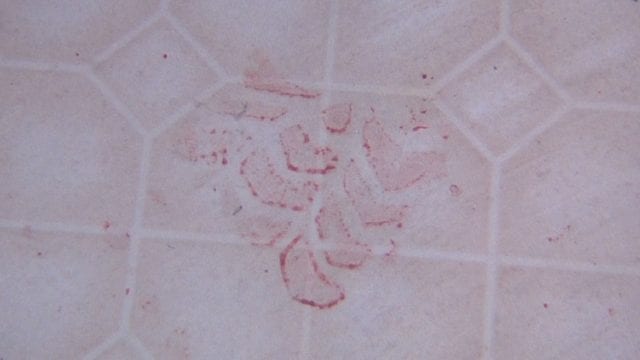
Harvey found Armstrong dead in the bathtub wearing a blood-soaked white Calgary Flames T-shirt and black Calgary Flames jogging pants.
There was dried blood everywhere. The paramedics estimated Armstrong had been dead for at least 12 hours. It was Sunday morning, May 22, 2011, at about 10:38 a.m. when Medicine Hat police showed up after a 911 call from Harvey.
Const. Kyle Batsel was one of two police officers who were first on the scene and the bathroom was a mess of blood.
“There was tons of it,” Batsel testified, according to the trial transcript.
Batsel told the court there was blood splatter and droppings at the entrance to the bathroom and it grew thicker past the sink. There was a camouflage ball cap in the toilet and above that a large spray pattern.
“Almost as if someone turned him around or his body got turned around after he was cut and there was just blood all over the wall, dripping right down above the toilet, across the…shower curtain,” said Batsel.
Armstrong was in the bathtub lying on the left side of his body, almost in a fetal position. His head was down and his glasses were askew, half off his face. Armstrong was wearing what appeared to be a moccasin-type slipper and Batsel noticed there was a bloody print on the floor that “was either a boot or a shoe…it was not slippers…that was not his footprint.”
Medicine Hat police investigators tried tracking down the source of the partial boot print. They sent the image to an RCMP footwear database in Ottawa in hopes of finding a match, but came up empty, according to testimony from Sgt. Ernst Fischhofer, who was head of the police department’s forensic unit.
Medicine Hat police investigators went to the local Walmart and compared boot treads. Fischhofer said he also searched hundreds of Google images in a fruitless hunt for a match.
He said investigators were able to determine the boot print likely came from a size 11 men’s work boot with a double “E” width. Investigators, however, never compared the boot print to Oakes’ foot size.
Oakes is a small woman, standing at about 5’4.
Secondiak said police have a theory about the boot print’s origin.
“We believe it was from a boot that was taken from the house. There were shoes thrown all about in the entryway. We believe it was from a boot that was taken from there…we have no grounds to believe that, it is a working assumption,” said Secondiak.
“Wendy told us they were there for hours. That led us to believe that possibly they were destroying evidence, cleaning things, destroying things, leaving false things for the police.”
During her testimony, Scott claimed she thought Oakes wore “CAT” work boots the day of the murder.
Oakes said in an interview with APTN she once owned Harley Davidson boots, but she had lost them by May 2011.
“I had a lot of high heels,” said Oakes.
Wendy’s Stories
Before Scott admitted to involvement in the murder, she suggested three different people, two men, and one woman, may have been involved in the killing.
The woman Scott identified had reddish hair, drove a red car, and was nicknamed “Ginger.”
Scott said one of the men, Chris Ashby, showed up at a friend’s house covered in blood and looking to sell Oxycodone pills. A Medicine Hat police constable testified during the trial that police found a pill bottle in Armstrong’s residence with a prescription for 60 Oxycodone pills, but there were only 20 left.
Ashby testified he was at a cousin’s house in Moosomin, Sask., that weekend. The cousin also testified during the trial to back up the alibi.
Scott is described by friends as a kind-hearted girl who would do anything for anybody. Originally from Brooks, Alta., Scott moved to Medicine Hat to escape the heat she and her boyfriend were feeling following a string of bad deals involving drugs. Friends say she was easily used and was known for lying.
On the stand during the trial, Scott said she would consider someone a friend after meeting them just once if she thought they were nice. She also had the mind of a child, according to Secondiak and Crown prosecutor Dolan.
Scott was a small-time crack dealer, supplied by at least one friend who also tried to look after her. Crack was the drug that brought Oakes and Scott together.
Oakes said she met Scott in the winter of 2011 at an apartment where an old acquaintance used to live. Oakes said she went there with a friend to buy crack and Scott gave her some for free.
“She said don’t worry about it, a friend of (the acquaintance) is a friend of hers,” said Oakes, during her interview Saturday with APTN. “It shocked the person I took there.”
Scott moved into Oakes’ trailer in May 2011 at the request of the acquaintance, said Oakes. Scott had no place to live and was sleeping in hotels.
“There was no friendship. The only reason I let her move in with me was as a favour,” said Oakes. “She was homeless and had no place to go.”
Scott offered a different version of events in her testimony during the trial.
Scott said she first met Oakes at Oakes’ trailer. She also initially testified she sold crack to Oakes two or three times a week.
Scott changed her story after she was challenged by Royer during cross-examination and admitted she met Oakes only twice before she moved into the trailer.
Sometime between the late evening of May 20, 2011, or in the early morning hours of May 21, 2011, Scott said Oakes woke her up and asked her to go for a ride.
“I woke up and Connie said, ‘let’s go for a ride.’ And I never thought anything about it, so I got in the car,” Scott testified.
Scott said she didn’t know who owned the red car Connie drove to Armstrong’s residence. During her testimony, Scott said she couldn’t remember the actual day of the murder, only that it happened during the May long weekend.
Scott said during her testimony she lied repeatedly while under oath during police interrogations. Scott said she lied when she told police she never entered the trailer and stayed in the red car, which she claimed was parked on the street because there was a truck in the driveway.
Scott also said she lied to police when she said they went to Armstrong’s trailer on a sunny and warm day. Scott gave police several different times of day for the murder, ranging from noon to after supper.
She testified it was actually cloudy and raining and they went to Armstrong’s residence after supper because “it was dark.”
During the trial, Scott testified the door was unlocked when they arrived at Armstrong’s trailer. She followed Oakes inside. She said the television was off.
“And so we went to his trailer. I’d never been to this trailer before, so I didn’t know the person or anything. Connie’s like, ‘let’s go inside.’ So I went inside and I stood at the doorway and she went down towards the bathroom. All of a sudden, I heard screaming. So I went to see what the matter was and she was standing over Casey, stabbing him.
“By that time, there was blood everywhere. There was nothing I could do,” said Scott during her testimony, according to a transcript of the proceedings.
The testimony differed from the facts Scott agreed to when she pleaded guilty to the murder. She was facing life with no chance of parole for 25 years, but after the guilty plea, she was sentenced to life with no chance of parole for 10 years.
In the agreed to statement of facts, Scott said the television was on when she walked into the trailer.
“Connie and Wendy heard noise in the bathroom so they proceeded walking down the hallway towards the bathroom. Connie walked ahead of Wendy. Connie was carrying a knife. Connie caught Casey off guard and stabbed him with the knife in the upper chest area. Casey began to bleed heavily and fell against the toilet. Connie attacked Casey again stabbing him in the neck with the knife. Casey was screaming for Connie to stop. Connie stabbed Casey again in the neck,” according to the agreed to statement of facts.
According to the autopsy report, Armstrong died from either one or two knife wounds to the neck which severed his “external and internal jugular, carotid artery, vagus nerve, esophagus and trachea.”
The stab wound or wounds nearly severed his neck. While there was evidence Armstrong had cuts on his arms, the only stab wounds he received were to the neck.
Scott testified she saw Oakes stab Armstrong in the arm. She said she never saw Oakes stab him in the chest.
“One of the things that Wendy suggested was impossible,” said Royer, in an interview with APTN. “Wendy Scott alleged that Casey Armstrong screamed at the time of his murder. As we heard the police officer say (during testimony), a knife went through his neck and left very little hanging on. I don’t see how he could have possibly screamed at the time of his death.”
In her initial testimony during the trial, Scott said Armstrong died on the bathroom floor and she helped Oakes lift the body and place it into the bathtub.
Under cross-examination, Scott’s story faltered.
From the trial transcript:
Royer: So my suggestion to you is that because there’s blood on the shower curtain four feet high and above his head in the tub, he must have been alive when you placed him in the tub. Was he?
Scott: Yes.
Royer: He was alive now when he was in the tub.
Scott: Uh-hum.
[….]Royer: My suggestion to you is that Mr. Armstrong was never picked up and put in that tub.
Scott: Yes, he was.
Royer: But he actually ran to the bathroom and jumped in the tub trying to escape.
Scott: No, he was, he was put there. I know, I was there.
Royer: So when you earlier testified that he was dead prior to putting him in the tub, you were mistaken in that regard?
Scott: Yes, I was mistaken. Yes.
Royer: You forget he was alive when you put him in the tub?
Scott: I am not saying that I forgot. It’s just something I didn’t come forward with.
Royer: How about this…You’re willing to agree with people when they suggest things to you.
Scott: No, I am not.
Fischhofer testified Armstrong was still spurting blood in the bathtub. He said the blood showed an upward trajectory splash pattern above the tub.
Scott testified Oakes handed her a rag to clean up the blood in the bathroom after the killing. Scott said she tried to clean up the blood, but there was so much she couldn’t handle it and stopped.
Fischhofer testified there was no evidence of any blood clean-up in the bathroom.
Scott also said they changed their bloodied clothes in one of the bedrooms and put their soiled garments into a green garbage bag. Scott testified Oakes put the knife used in the murder in the green garbage bag.
She said they put the green garbage bag into the trunk of the car and drove back to Oakes’ trailer. Scott said Oakes dumped the green garbage bag into a trash bin.
Scott then claimed in her testimony that Oakes used the same knife in an armed robbery a few days later at a store up the street from their trailer. Oakes pleaded guilty to the June 3, 2011, armed robbery and was serving time in Edmonton for the incident when she was charged with Armstrong’s murder.
Police recovered the knife used in the armed robbery after they arrested Oakes, who was initially accosted by locals. Oakes had taken cigarettes, popcorn and cash. Scott walked with Oakes to the store, but turned around and went back home before the robbery.
The Knife
Scott said the knife used in the murder was Oakes’ “favorite” and she carried it blade down stuffed into the back of her pants. The 12-inch knife resembled a large chef’s knife with a black handle. The knife had an eight-inch blade.
The eight-inch knife confiscated by police during the armed robbery was submitted as an exhibit and Scott identified it as the murder weapon.
“That’s the knife that I saw at Casey’s, so that’s my evidence,” said Scott, according to the trial transcript.
When pressed by Royer during cross-examination on how Oakes could throw out the knife and then use it a few days later in an armed robbery, Scott changed her story.
“She has two exactly identical,” said Scott.
“So now there’s not a favourite knife. There’s a variety of knives. Is that right?” said Royer, according to the transcript.
“Yes,” said Scott.
Medicine Hat police investigators sent the knife for testing to a lab in Edmonton and then to an RCMP lab in Vancouver where the handle was taken apart. The tests found no traces of blood or any DNA on the knife.
Secondiak admits police failed to tie the knife to the murder.
“We found a knife that possibly could have been used,” he said, in an interview with APTN. “But there was not enough forensic evidence to link it directly to the murder weapon.”
Oakes chuckles at Scott’s claim she carried a chef’s knife stuffed down the back of her pants. She did on occasion carry a jackknife for protection. Oakes said she grabbed the knife used in the armed robbery from a wooden holder in her kitchen.
Royer raised issues around the knife’s admissibility during the trial and now worries the use of the knife as an exhibit could have led the jury down the wrong path.
“Despite the fact…there is no evidence to suggest (the knife) has anything to do with the murder, (the jury) may have somehow believed it was of some relevance to confirm any part of Wendy’s evidence,” said Royer.
Dark Road from Nekaneet
Without Scott’s admission, Armstrong’s killing would have turned into a cold case. Medicine Hat police investigators ran out of leads after eight months of investigating the murder.
Police then changed the investigators on the file and Secondiak was put in charge.
“We reviewed all the documents, all the statements and we noticed some discrepancies, specifically with (Scott’s) statements. We had that analyzed. We believed at that time she was lying in her statements,” said Secondiak. “So we brought her back in for re-interviews. There was a few of them and during one of those she confessed to the homicide.”
Police interrogators told Scott that Oakes gave her up.
“I heard she was laying the blame all on me,” Scott testified.
But it wasn’t true.
Investigators moved quickly following Scott’s admission. Oakes was on the final leg of her sentence in the Edmonton federal prison for the armed robbery. She received a message from a prison official one morning. Someone wanted to see her.
Oakes walked into one of the prison’s offices and said a Medicine Hat police officer tried to give her a hug.
“I pushed him back,” said Oakes.
It was 8:30 a.m., said Oakes.
She was interrogated until 3:30 p.m.
“They had a camera and tape recorder and they kept asking me to fess, telling me to fess. ‘We know you did it, just fess up,’” said Oakes. “And I said I’m not admitting to anything that I didn’t do.”
Oakes said the officers told her Scott placed her at the scene of the murder.
Oakes said she was charged and sent back to the Medicine Hat remand centre in the early winter of 2012.
She said she was interrogated for three weeks by police, but Oakes refused to admit to the murder.
After Oakes was charged, she telephoned her adopted mother Margaret Oakes.
“I picked it up and she said, ‘I was charged with murder,’” said Margaret Oakes. “I said, ‘What?’ I couldn’t believe what she was telling me. She said, ‘I didn’t do it. I may be crazy but I didn’t do it.’ I told her I believed her.”
Connie Oakes is no stranger to courtrooms or prisons. Her criminal record notes 75 convictions across Alberta and Saskatchewan stretching back to 1983.
Each entry is a marker along the path she travelled since leaving her home community of Nekaneet First Nation, a southern Saskatchewan Cree reserve nestled in the stunning Cypress Hills which roll to the horizon like a sun-singed green ocean.
The community sits at the end of a groomed gravel road about 40 km southeast of Maple Creek.
While Oakes recalls an idyllic childhood picking berries and riding horses, there was also a darkness shrouding her early years in Nekaneet.
Oakes said she was sexually abused by an older cousin. The abuse started when she was 11 years old. She chose to attend the Lebret Indian residential school near Fort Qu’Appelle, Sask., to escape the abuse. There, she ran into more sexual and physical abuse from school officials and older students.
Oakes hit the highway at 18 and moved to Regina. She became hooked on “soft,” a cocaine mixture injected into the vein. She plunged into a life of crime and punishment.
After she left prison in 2002 following her sentence on the Medicine Hat drug conviction, Oakes began to put her life back together, landed a job as an addictions councillor in her home community and focused on raising her two remaining sons, Joe and Jared.
But, after experiencing friction with the community’s chief at the time, she was fired on Treaty Day.
Oakes moved back to Medicine Hat with her sons, started taking classes to upgrade her education, but found it difficult to juggle studies while also caring for her boys.
“It just went downhill,” said Oakes.
Her oldest son Joe turned 18 and went to live with his father and she put her youngest son Jared in the care of Margaret Oakes.
Crack and alcohol then pulled her under.
Oakes’ long criminal history and her Cree heritage played a large role in landing her as a murder suspect, said her aunt Linda Oakes who wonders why police discounted the other three people Scott accused of the killing.
“Was it because they were Caucasian that they weren’t charged and then Connie Oakes comes along and they charge her?” said Linda Oakes. “How come they weren’t charged? Because they were white.”
Connie Oakes is now working in the kitchen at the Edmonton Institution for Women, preparing meals and cleaning trays.
She has her own cell in the maximum security section of the prison. There are six other women in her section, five of them are Cree. She smudges every day and seeks counselling from the elders who work there.
She’s been imprisoned since 2011. Her mind and body are finally clean. When she looks back at her drug and drink drenched years, it all blurs together.
“But me not committing this crime is not a blur. I know I didn’t do it,” said Oakes. “I have a good idea who did, but I can’t say for sure.”
Back home, on the farm, with cattle lost in the art of grazing amidst the Cypress Hills, her youngest son Jared Oakes, 13, imagines the moment when he will see his mother again.
“I’d say I love you,” he said. “I’m glad you’re out. It’s been a long time.”



